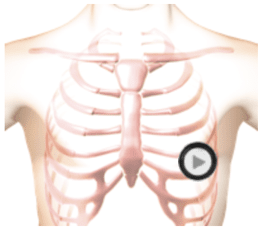On this page, we present an example of moderate regurgitation of both the aortic and mitral valves.
The first heart sound is minimally decreased due to minimal closure of the mitral valve leaflets in early systole. The second heart sound is normal.
There is a rectangular murmur which takes up most of systole and a decrescendo murmur which takes up most of diastole. Both murmurs are of moderate intensity.
The combination of the two murmurs creates a to-and-fro sound character.
In the anatomy video you see an enlarged left atrium and left ventricle.
You see regurgitant turbulent flow into the left atrium from the left ventricle (the systolic murmur) and regurgitant turbulent flow from the aorta into the left ventricular outflow tract (the diastolic murmur).
Mitral Regurgitation and Aortic Regurgitation Audio


Technique

The patient's position should be sitting leaning forward.
Auscultation Tips for Mitral Regurgitation and Aortic Regurgitation
S1:Minimally reduced intensitySystole:Rectangular murmur, moderate intensity
Diastole:Decrescendo murmur, moderate intensity
Sound Wave
Mitral Regurgitation and Aortic Regurgitation Video
Play the animation and take note of an enlarged left atrium and left ventricle.
Observe regurgitant turbulent flow into the left atrium from the left ventricle (the systolic murmur) and regurgitant turbulent flow from the aorta into the left ventricular outflow tract (the diastolic murmur).
Authors and Sources
Authors and Reviewers
- ECG heart rhythm modules: Thomas O'Brien.
- ECG monitor simulation developer: Steve Collmann
-
12 Lead Course: Dr. Michael Mazzini, MD.
- Spanish language ECG: Breena R. Taira, MD, MPH
- Medical review: Dr. Jonathan Keroes, MD
- Medical review: Dr. Pedro Azevedo, MD, Cardiology
- Last Update: 11/8/2021
Sources
-
Electrocardiography for Healthcare Professionals, 6th Edition
Kathryn Booth and Thomas O'Brien
ISBN10: 1265013470, ISBN13: 9781265013479
McGraw Hill, 2023 -
Rapid Interpretation of EKG's, Sixth Edition
Dale Dublin
Cover Publishing Company -
EKG Reference Guide
EKG.Academy -
12 Lead EKG for Nurses: Simple Steps to Interpret Rhythms, Arrhythmias, Blocks, Hypertrophy, Infarcts, & Cardiac Drugs
Aaron Reed
Create Space Independent Publishing -
Heart Sounds and Murmurs: A Practical Guide with Audio CD-ROM 3rd Edition
Elsevier-Health Sciences Division
Barbara A. Erickson, PhD, RN, CCRN -
The Virtual Cardiac Patient: A Multimedia Guide to Heart Sounds, Murmurs, EKG
Jonathan Keroes, David Lieberman
Publisher: Lippincott Williams & Wilkin)
ISBN-10: 0781784425; ISBN-13: 978-0781784429 - Project Semilla, UCLA Emergency Medicine, EKG Training Breena R. Taira, MD, MPH
-
ECG Reference Guide
PracticalClinicalSkills.com
Mitral Regurgitation and Aortic Regurgitation | #105